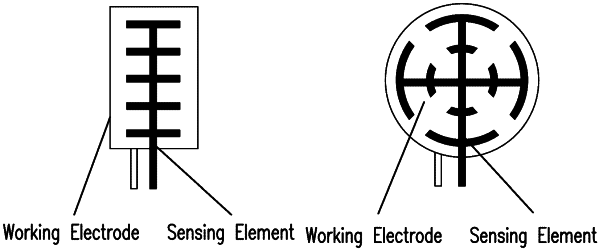| CPC G01N 27/4167 (2013.01) [C12Q 1/001 (2013.01); G01N 27/302 (2013.01); G01N 27/34 (2013.01); G01N 27/36 (2013.01); G05D 21/02 (2013.01)] | 20 Claims |

|
1. A device for controlling pH of a solution on an array of electrodes, the device comprising:
a support; and
an array of electrodes comprising:
one or more feedback-controlling electrode set(s) that each includes:
one or more reference electrode(s);
one or more counter electrode(s); and
one or more subset(s) comprising a pH sensing element electrically coupled, directly or indirectly, to a working electrode;
wherein:
a reference electrode of the one or more reference electrode(s) and/or a counter electrode of the one or more counter electrode(s) is electrically coupled, directly or indirectly, with at least one of the one or more subset(s);
one or more non-feedback-controlling electrode set(s) that each does not comprise a pH sensing element and that each comprises:
one or more reference electrode(s) of the respective non-feedback-controlling electrode set(s);
one or more counter electrode(s) of the respective non-feedback-controlling electrode set(s); and
one or more working electrode(s) of the respective non-feedback-controlling electrode set(s);
for each of the non-feedback-controlling electrode set(s), each of the one or more reference electrode(s) of the respective non-feedback-controlling electrode set and/or each of the one or more of the counter electrode(s) of the respective non-feedback-controlling electrode set is electrically coupled, directly or indirectly, with at least one of the working electrode(s) of the respective non-feedback-controlling electrode set;
the device is configured to iteratively perform the following:
a) select a respective amount of current and/or voltage to be applied to at least one of the one or more working electrode(s) of the respective feedback-controlling electrode set(s) in order to minimize a difference between a signal output of the coupled pH sensing element(s) and a target sensing value;
b) apply the selected respective amount of current and/or voltage to the at least one of the one or more working electrode(s) of the respective feedback-controlling electrode set(s) to change pH of a solution close to the respective working electrode(s) of the respective feedback-controlling electrode set(s); and
c) measure the signal output of the coupled pH sensing element(s);
the electrical couplings are through solid electrically conductive material; and
at least one of the feedback-controlling electrode set(s) is (a) electrically coupled, directly or indirectly, to at least one of the non-feedback-controlling electrode set(s), and (b) is configured to apply the selected amount of current and/or voltage, which is applied to the one or more working electrode(s) of the at least one coupled feedback-controlling electrode set(s), also to one or more of the working electrode(s) of the respective coupled at least one non-feedback-controlling electrode set(s).
|